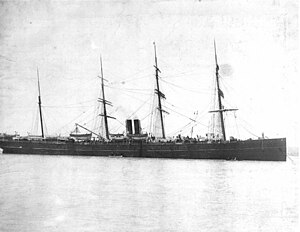City of Peking

City of Peking anchored in San Francisco Bay, May 1898.
|
|
| History | |
|---|---|
|
|
|
| Name: | City of Peking |
| Namesake: | Peking (now Beijing), China |
| Owner: |
|
| Operator: |
|
| Port of registry: |
|
| Route: | San Francisco to Yokohama and Hong Kong |
| Builder: | John Roach & Sons, Delaware River Iron Ship Building and Engine Works |
| Yard number: | 130 |
| Launched: | March 19, 1874 |
| Maiden voyage: | February 1875 |
| Fate: | Scrapped, 1920 |
| General characteristics | |
| Type: | Passenger freighter |
| Tonnage: | 5,079 gross |
| Length: | 423 ft |
| Beam: | 47 ft 4 in |
| Draft: | 38 ft 6 in |
| Propulsion: | 5,000 horsepower compound steam engine, screw propeller, auxiliary sails |
| Speed: | 14.5 knots |
| Capacity: | 120 1st class, 250 2nd class, 1,000 steerage class passengers |
SS City of Peking was an iron-hulled steamship built in 1874 by John Roach & Sons for the Pacific Mail Steamship Company. City of Peking and her sister ship City of Tokio were at the time of construction the largest vessels ever built in the United States, and the second largest in the world behind the British leviathan Great Eastern.
Like Great Eastern, construction of the two Pacific Mail ships was to be plagued with financial difficulties, which threatened to bankrupt the shipbuilder. Unlike Great Eastern, however, which was a commercial failure, City of Peking would go on to have a long and successful commercial career.
In addition to her cargoes, City of Peking brought many Chinese and Japanese immigrants to the United States, and later served as a troopship in the Spanish–American War.
In 1865 the Pacific Mail Steamship Company had obtained a $500,000 annual subsidy from the U.S. Congress to operate a steam packet between the United States, China and Japan. On June 1, 1872, Congress approved an additional $500,000 subsidy, raising the company's total subsidy to one million dollars annually. Under the terms of the statute, the new subsidy was contingent upon the company increasing its packet to a monthly service beginning on October 1, 1873 and continuing for a period of ten years. The statute also stipulated that the company must utilize iron ships of at least 4,000 tons for the service, built in the United States and suitable for conversion into naval auxiliaries in the event of war.
With the incentive of the new half million dollar subsidy, Pacific Mail decided to upgrade its entire fleet of aging wooden side-wheelers with new iron vessels. The company it chose to build its new fleet was John Roach and Sons, which had recently opened a state-of-the-art shipyard, the Delaware River Iron Ship Building and Engine Works, in Chester, Pennsylvania.
...
Wikipedia
